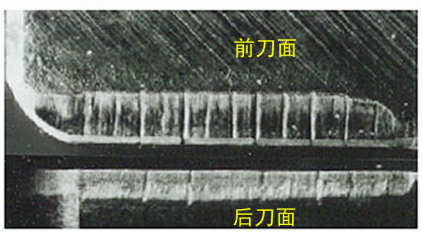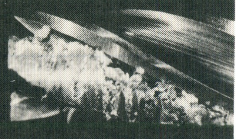
In the first two articles, the author introduced the milling process and the performance characteristics of the tool. As the most widely used cold working process after turning, the "omnipotent" milling tool is actually very fragile. In this article, the author will introduce the three most common failure modes of milling cutters and their countermeasures: edge breakage, thermal cracking and chip fusion.
1. The most common form of failure: edge damage
Determined by the intermittent cutting conditions in which the milling cutter is located, edge breakage is the most common failure form of milling cutters.

Possible reasons for cutting edge breakage include:
Unfavorable cutting conditions.
If the rotation speed is too high or the feed per tooth is too large, the load on the cutting edge is too large, or the parameters do not match the selection of the number of teeth, resulting in the blockage of chips that cannot be discharged and accompanied by secondary cutting.
Improper use of cutting fluid.
The mechanical load and thermal load brought by intermittent cutting form alternate impact on the cutting edge. Therefore, the selection of milling cutting fluid needs to take into account the requirements of heat conduction and fluidity.
Insufficient cutting edge strength.
Taking the solid carbide milling cutter as an example, in the past, the way of passivating the cutting edge by hand by grinding workers and using whetstone could not guarantee the passivation effect, and could not adapt to the large-scale mechanized production.
With the development of passivation technology, the passivation control of milling cutter cutting edge is becoming more and more mature.
For example, the abrasive type and passivation time of the abrasive passivation machine can be controlled to obtain a stable cutting edge passivation arc value. The author believes that the cutting edge passivation technology is a detail improvement for the cutting technology of the tool. Appropriate passivation of the cutting edge can eliminate the micro chipping left on the cutting edge during the manufacturing process of the cutting tool, so that the tool can pass the initial wear stage smoothly. Improve tool chipping resistance.
System rigidity effects.
Here I have to mention again the harsh machining conditions of the milling cutter, which makes the milling cutter extremely unstable during processing. If this time encounters an "unreliable" system again. For example, workpiece clamping rigidity, tool clamping method (tool holder selection and wear) and even workpiece structural defects (thin wall, etc.) will double the damage of cutting vibration.
Regarding the countermeasures to solve the breakage of the cutting edge of the milling cutter, it is necessary to distinguish according to the type of milling cutter:
Solid milling cutter
Decrease feed or depth of cut.
Wet to dry. (blow compressed air)
Edge grinding. (R0.01~0.03 degree)
Make a small chamfer on the tip of the knife.
Check the runout of the spindle and the tool.
indexable blade
Reduce feed and depth of cut.
Wet to dry (blowing compressed air).
Check the tool material selection for problems.
Second, the consequences of intermittent processing: thermal cracking
The main failure form of milling inserts is chipping. In addition to chipping caused by mechanical reasons (such as abrasive impact), thermal cracking caused by thermal shock is also an important failure cause, as shown in the figure below. shown.

It occurs when heating during cutting and cooling during idling are applied alternately and repeatedly. Especially when water-soluble cutting fluids with high cooling properties are used, they often expand rapidly.

In particular, cutting fluid must be used when milling workpiece materials and superalloys that are prone to thermal deformation.
The cutting fluid can reduce friction, take away the heat accumulated on the cutting edge, and inhibit the formation and fusion of built-up edge.
2. Chip fusion caused by comprehensive factors.
The defect of chip fusion is more common in the case of processing shaped metal, as shown in the figure below

The causes of damage are mainly concentrated in the following aspects:
NO.1 Improper selection of cutting fluid and poor cooling effect.
For example, oily cutting fluid is selected, which cannot effectively remove the cutting heat from the cutting edge in time.
NO.2 The helix angle of the cutting edge is small.
As mentioned earlier, the helix angle of the cutting edge is the rake angle of the milling cutter. If the rake angle is too small, the cutting force will increase, the metal deformation will also increase, and the cutting heat generated by the material deformation will also increase.

NO.3 Use uncoated products.
In addition to the angle of the tool, which increases the cutting heat from the direction of material deformation, whether the tool surface is coated, that is, the friction coefficient of the tool surface, will also significantly affect the heat generation during processing, resulting in chip fusion problems.
Similarly, the countermeasures to the problem of chip fusion are different for different types of milling cutters:
solid carbide
Change to a coated tool, or improve the polishing quality of the tool surface and reduce the friction coefficient of the tool surface.
Use wet cutting.
Use water-based cutting fluid, or increase the amount of cutting fluid.
Choose a blade shape with a large helix angle.
Indexable Insert End Mills
Increase cutting speed and feed.
Choose materials with good fusion resistance.
Choose a blade shape with a large rake angle.
Reduce the amount of edge grinding.
Due to the limited space, the author only analyzes the mechanism and explains the countermeasures for the three most common failure modes of milling cutters: edge damage, thermal cracking and chip fusion. Readers with similar processing applications and tool failure problems are welcome. Participate in discussions about your app dilemma and ways to improve it.